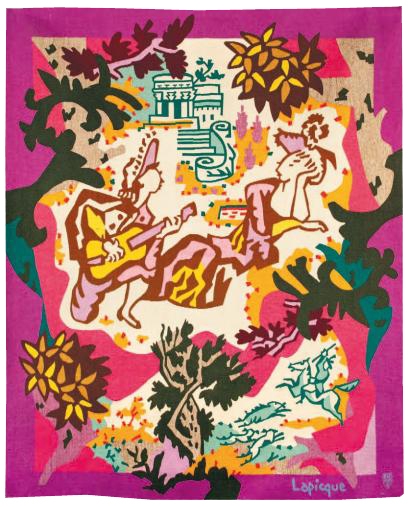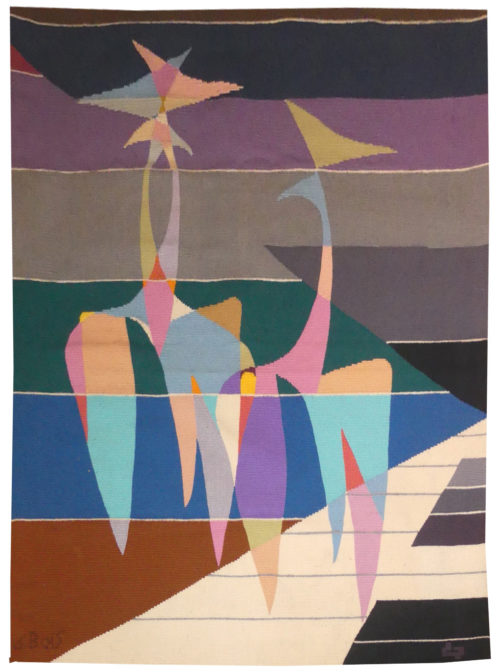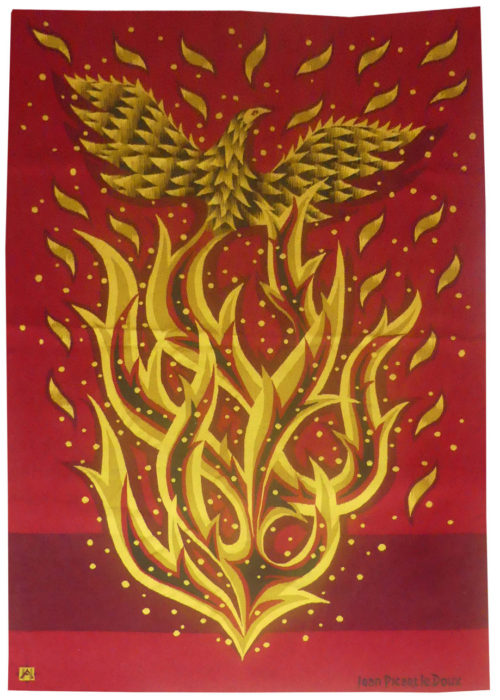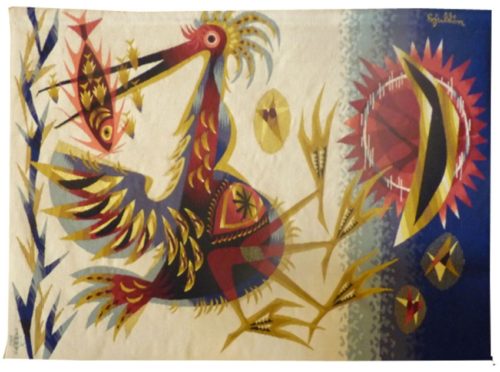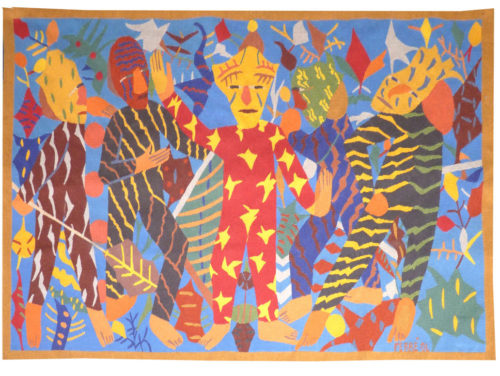-
Figure de trois (Triplet)
Tapestry woven by the Saint-Cyr workshop. With signed label, n°1/6. Circa 1970. An unknown artist, whose inspiration finds its source in the instruments and theory of Music ; a geometric evocation of a keyboard and the stave serve as a framework for the cartoon. -
Le phénix (the phoenix)
Aubusson tapestry woven in the Hamot workshop. Complete with label signed by the artist, n°EA. 1965. Jean Picart le Doux is one of the foremost figures in the renaissance of the art of tapestry. His earliest contributions to the field date back to 1943 when he designed cartoons for the passenger ship “la Marseillaise”. A close associate of Lurçat, whose theories he would adopt (limited palette, numbered cartoons...), he was a founding member of the A.P.C.T. (Association des Peintres-cartonniers de Tapisserie), and soon after, a teacher at the Ecole Nationale Supérieure des Arts Décoratifs. The state gave him several commissions most of them at the Aubusson workshop, and some at the Gobelins : the most spectacular of these being for the University of Caen, the Theatre in Le Mans, the passenger ship France or the Prefecture of the Creuse département ... In as much as Picart le Doux’s aesthetic is close to that of Lurçat, so also is his inspiration and his subject matter, although in a register which is more decorative than symbolic, where he brings together heavenly bodies (the sun, the moon, the stars...), the elements, nature (wheat, vines, fish, birds...), man, literary quotation ... « Le Phénix » (The Phoenix) (An identical lithograph exists also), a subject inspired by legend (a rare event in the work of Picard le Doux) reproduces a chromatic harmony of yellow motifs against a red background typical of this particular artist. Bibliography : Maurice Bruzeau, Jean Picart le Doux, Murs de soleil, Editions Cercle d’art, 1972, ill. n°162 Exhibition Catalogue, Jean Picart le Doux, tapisseries, Musée de Saint-Denis, 1976 Exhibition Catalogue Jean Picart le Doux, Musée de la Poste, 1980 -
Envie et Gourmandise (les pêchés capitaux) (Envy and Gluttony – the seven deadly sins)
Aubusson tapestry woven in the Legoueix workshop. Complete with certificate of origin signed by the artist. 1956. After the traditional completion of some mural paintings in the 1930’s, he then arrived in Aubusson in 1936, became closely associated with Picart le Doux in 1947 and then joined the A.P.C.T. (Association des Peintres-Cartonniers de Tapisserie). From then on he devoted himself to tapestry with zeal and designed 167 cartoons, at first figurative following on from Picart le Doux and Saint-Saëns, then, influenced by the scientific themes that he dealt with, tending more towards abstraction. In 1981, two years before his death, he donated his studio to the Musée départemental de la tapisserie in Aubusson. « He considers… in this short but extremely witty series, the vices and his treatment reveals a malicious sense of humour returning in an original way to a theme much used during the middle ages.” (Exhibition catalogue “Hommage à Louis-Marie Jullien, Aubusson, Musée départemental de la Tapisserie, 1983, p.4) Here the subject is a pretext for the representation of animals such as can be found in the work of his contemporaries, notably Picart le Doux with whom he was closely associated. According to the 1983 exhibition catalogue (which is considered to be the catalogue raisonné and in which this piece appears as number 53), only one tapestry was ever woven from this cartoon: it is thus unique. Bibliography : Exhibition catalogue Hommage à Louis-Marie Jullien, Aubusson, Musée départemental de la Tapisserie, 1983 -
Danseuses cambodgiennes (Cambodian dancers)
Tapestry woven at Aubusson by the Picaud workshop. Certificate of origin, n° 1/4. Circa 1965. Although somewhat overlooked now, the contribution that Maurice Ferréol made, in the 1960’s, to the design of figurative tapestry is quite remarkable. He proposed a style redolent of popular imagery where the use of pure blocks of colour exacerbates the almost childlike outline of the figures. What connects these bright and garishly coloured, masked figures to Cambodia? They are simply a pretext for a profusion of colours and motifs in the particular characteristic style of Ferréol.


